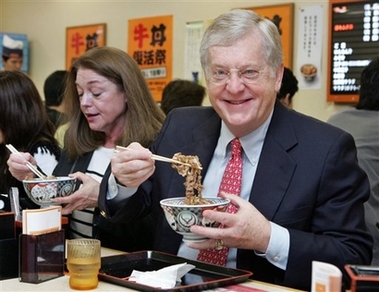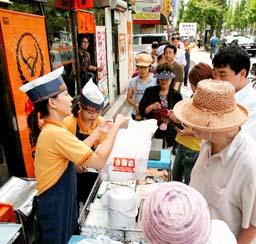

U.S. Ambassador to Japan Thomas Schieffer, right, is all smiles as he tries out beef bowl with his wife Susanne, left, at Yoshinoya in Tokyo, Monday, Sept 18, 2006. Japanese queued up before a downtown Tokyo fast-food chain on Monday as the restaurant began offering the first servings in more than two years of a popular rice dish topped with American beef. (AP Photo/Pool)
Something tells me he didn’t have to wait all night.
The US coverage of the return of US beef has something of a relieved/celebratory feel to it:
Sept. 18, 2006, 1:48AM
Japanese Line Up for American Beef
By YURI KAGEYAMA AP Business Writer
© 2006 The Associated Press
TOKYO — The U.S. Ambassador was among customers thronging a major Japanese fast-food chain Monday to savor the return of a popular rice dish topped with American beef that was off the menu for more than two years due to mad cow fears.
“It was great. It was well worth the wait,” U.S. Ambassador Thomas Schieffer said after eating Yoshinoya D&C Co.’s “beef bowl” with chopsticks.
Click to learn more…
Japan and nearby South Korea banned American beef in December 2003 because of fears about mad cow disease. Japan eased the ban in July, and South Korea earlier this month.
Mad for U.S. beef, herd heads for Tokyo eatery
POSTED: 9:22 a.m. EDT, September 18, 2006
TOKYO, Japan (Reuters) — Hundreds of people lined up at a central Tokyo restaurant on Monday to savour a dish not tasted for more than two years — “beef bowl” made with U.S. meat.
Some Japanese had even camped out overnight outside a popular branch of fast-food chain Yoshinoya, which resumed sales of its famed specialty following the July lifting of a government ban on imports of U.S. beef.
The ban was imposed in December 2003 after the discovery of the first U.S. case of mad cow disease, forcing Yoshinoya to drop its flagship dish of braised beef and onions marinated in soy sauce and laid on top of rice.
Hardcore fans had shunned the “beef bowl” when it was made with Australian beef because the meat was too lean.
As happy as I am to see Yoshinoya back in action, I don’t really see the reopening of beef trade a cause for consumers to celebrate, especially in the US. The flap over beef could have served to make the US consider whether its own testing standards were protecting consumers, but that never happened. The US government is shamelessly pro-business and the media is just not interested in covering FDA topics unless they involve a scary new drug that kills a tiny amount of people.
If you ask me (and you did) the US put way too much pressure on Japan to lift this ban in a relatively small export market (2 billion dollars a year in sales in Japan compared to 40 billion in premium revenues for US insurance companies). The dangers of mad cow are real and every country has to be careful. For the US industry to rush to political solutions (which as an industry supported by massive subsidies is their bread and butter) to the point of getting the president involved and threatening sanctions that would violate WTO rules rather than trying to reassure consumers only harms the United States’ image and makes the beef industry look bad as well. The compromise, which is basically that Japanese inspectors will be able to look around US slaughterhouses to ensure that no spinal tissue is getting into beef headed for Japan, seems satisfactory, but I would have liked to see a little more – perhaps a more constructive attitude toward testing from the American side – maybe not universal testing like Japan, but something more than self-regulation would be nice. Unfortunately, the US saw quick resumption of the status quo as more important than building consumer trust, and I think they’ll suffer for it.








